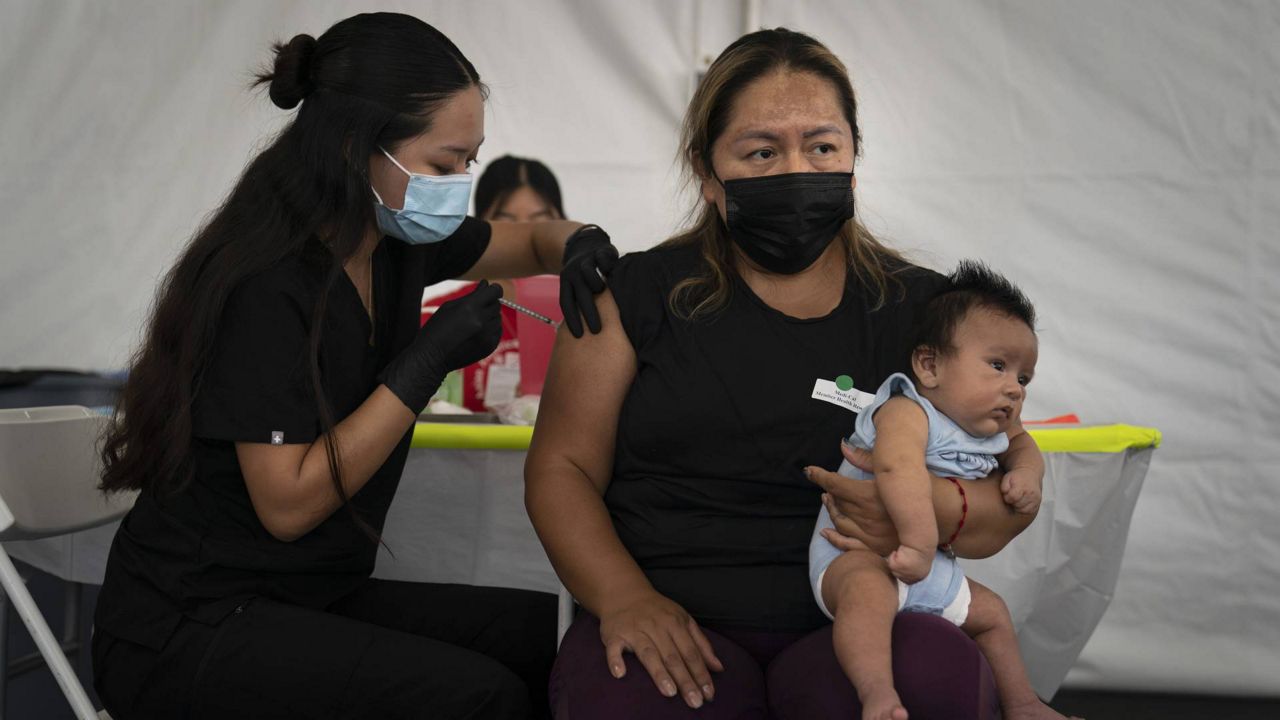SANTA ANA, Calif. (CNS) — Eighteen more Orange County residents have succumbed to COVID-19 this month, but hospitalization numbers declined since Friday, according to Orange County Health Care Agency data released Monday.
The 18 fatalities, which put the county's cumulative total at 5,220, have been logged since Friday. They all occurred this month, with the most recent happening on Aug. 19, and put the month's death toll at 45.
What You Need To Know
- Orange County logged 1,525 COVID-19 infections and 18 deaths since Friday
- Hospitalizations dropped from 592 on Friday to 546 on Monday
- The number of patients in intensive care increased from 132 to 139
- The case rate per 100,000 residents as of Aug. 21 was 35.9 for unvaccinated residents, but 6.5 for the fully vaccinated
The deadliest days so far this month have been Aug. 10 and Aug. 17 when five people each died on those dates. The county has not seen daily death rates that high since March 31.
Death is the final lagging indicator, experts say, so it reflects the ultimate toll from this summer's surge.
What's also unique about the deaths of late are the number of younger people succumbing to the virus. Another resident in the 25-34 age group has died since Friday, and a few more fell in the 35 to 44 age range, according to HCA statistics.
"The delta variant is not a heat-seeking missile for younger people," Andrew Noymer, an epidemiologist and UC Irvine professor of population health and disease prevention, told City News Service. "We have vaccinated a lot of the older folks so water runs downhill. It's not finding younger people because it's preferential. It's finding them because that's who is unvaccinated, so you're going to get more cases, more hospitalizations and more deaths in those age groups."
Vaccinations have steeply driven down the death toll each month since records were set in December and January, but it now appears they are trending back upward due to the more contagious delta variant of the virus.
The death toll for July was 17. That marks the first time since the winter surge that there has been a month-to-month increase in fatalities.
The death toll for June was 15, with 23 fatalities in May, 44 in April, 199 in March, 615 in February, 1,574 in January — the deadliest month of the pandemic — and 969 in December, the next-deadliest.
Noymer was somewhat encouraged that hospitalizations have dipped since Friday, but is still keeping an eye on the levels because he is concerned they may go back up again if there is a surge fueled by children returning to school.
"I'll be surprised if we really hit a peak," Noymer said.
Noymer noted he saw a news photo of cheering fans at a high school football game over the weekend.
"There wasn't a mask in sight," Noymer said.
Residents who are fully vaccinated should be concerned about breakthrough infections, Noymer added.
"This idea that breakthroughs are rare or mild — people know both of those things are lies," Noymer said.
Noymer, however, continues to encourage vaccination because it is the most effective way to stay healthy and avoid the virus.
"The one thing people can do if they're not vaccinated is to get vaccinated," Noymer added.
"We need to vaccinate and stop taking Ivermectin," Noymer said, referring to people across the nation taking de-worming medicine as a remedy despite warnings from health care experts that there is no evidence it is effective against the virus.
Orange County Supervisor Lisa Bartlett had a similar message.
"Really listen to our public health officer," Bartlett said, referring to Dr. Clayton Chau, who is also the county's director of the Health Care Agency. Chau has continued to tout vaccines as the only way out of the pandemic.
"He's dispensing some sage advice based on what he's seeing from the front lines day in and day out," Bartlett added.
Bartlett said last week she heard about five fully vaccinated residents who were infected with COVID-19.
"They said they didn't get hospitalized and they had some symptoms and weren't feeling well so they decided to get tested anyway" and found out they were COVID-19 positive, Bartlett said.
Bartlett says the county still has plenty of capacity to handle the surge of patients, but she is concerned about what impact more flu cases this fall and winter could mean.
"I'm concerned because there's a lot of COVID fatigue this time around," compared with last year when widespread masking tamped down the spread of flu, Bartlett added.
Related Stories
Hospitalizations dropped from 592 on Friday to 546 on Monday, according to the OC HCA. The county offers statistics from Mondays through Fridays, but no longer on the weekend. The number of patients in intensive care increased from 132 to 139.
Chau on Friday said hospitalized COVID-19 patients are "generally in their mid-30s to mid-40s."
The new infections reported Monday, raised the cumulative case count to 285,098.
The OCHCA released updated vaccination numbers Thursday, showing 1,989,131 fully vaccinated residents. That includes 1,857,185 who received the two-dose Moderna or Pfizer vaccines and 131,946 who received the one-dose Johnson & Johnson shot.
The case rate per 100,000 residents as of Aug. 21 was 35.9 for unvaccinated residents, but 6.5 for the fully vaccinated.
The county had 20.2% of its adult ICU beds and 69% of its ventilators available as of Friday. The OCHCA does not update its figures on weekends.
Health experts note that many of the infections being logged are due to an increase in testing and many are among vaccinated residents so the symptoms are not leading to serious illness requiring hospitalization. Some are being caught as patients are admitted to hospitals for unrelated reasons.
